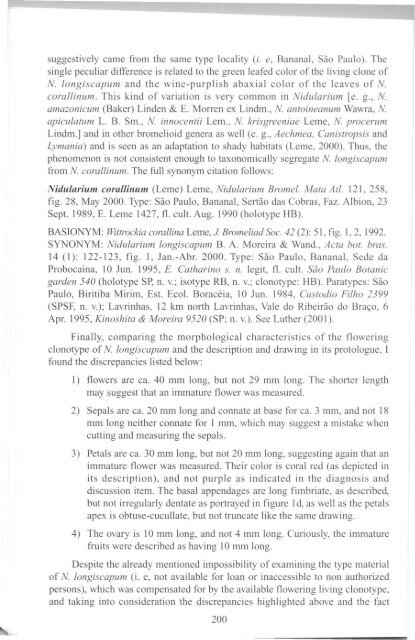Two Nidularium Species from São Paulo State, Brazil ... - CNCFlora
Two Nidularium Species from São Paulo State, Brazil ... - CNCFlora
Two Nidularium Species from São Paulo State, Brazil ... - CNCFlora
Create successful ePaper yourself
Turn your PDF publications into a flip-book with our unique Google optimized e-Paper software.
suggestively carne <strong>from</strong> the same type locality (i. e, Bananal, <strong>São</strong> <strong>Paulo</strong>). The<br />
single peculiar difference is related to the green leafed color of the living clone of<br />
N. longiscapum and the wine-purplish abaxial color of the leaves of N.<br />
corallinum. This kind of variation is very common in <strong>Nidularium</strong> [e. g., N.<br />
amazonicum (Baker) Linden & E. Morren ex Lindm., N antoineanum Wawra,N<br />
apiculatum L. B. Sm., N innocentii Lem., N krisgreeniae Leme, N procerum<br />
Lindm.] and in other bromelioid genera as well (e. g., Aechmea, Canistropsis and<br />
Lymania) and is seen as an adaptation to shady habitats (Leme, 2000). Thus, the<br />
phenomenon is not consistent enough to taxonomically segregate N longiscapum<br />
<strong>from</strong> N corallinum.The full synonym citation follows:<br />
Nidu/arium corallinum (Leme) Leme, <strong>Nidularium</strong> Brome/. Mata At/. 121,258,<br />
figo28, May 2000. Type: <strong>São</strong> <strong>Paulo</strong>, Bananal, Sertão das Cobras, Faz.Albion, 23<br />
Sept. 1989, E. Leme 1427,fl. cultoAug. 1990 (holotype HB).<br />
BASIONYM:WittrockiacorallinaLeme,J BromeliadSoc. 42 (2): 51,figo1,2, 1992.<br />
SYNONYM: <strong>Nidularium</strong> longiscapum B. A. Moreira & Wand., Acta botobras.<br />
14 (1): 122-123, figo I, Jan.-Abr. 2000. Type: <strong>São</strong> <strong>Paulo</strong>, Bananal, Sede da<br />
Probocaina, 10 Jun. 1995, E. Catharino s. n. legit, fl. culto<strong>São</strong> <strong>Paulo</strong> Botanic<br />
garden 540 (holotype Sp, n. V.;isotype RB, n. V.;clonotype: HB). Paratypes: <strong>São</strong><br />
<strong>Paulo</strong>, Biritiba Mirim, Est. Eco!' Boracéia, 10 Jun. 1984, Custodio Filho 2399<br />
(SPSF, n. v.); Lavrinhas, 12 km north Lavrinhas, Vale do Ribeirão do Braço, 6<br />
Apr. 1995,Kinoshita & Moreira 9520 (SP; n. v.). See Luther (200 I).<br />
Finally, comparing the morphological characteristics of the flowering<br />
clonotype of N longiscapum and the description and drawing in its protologue, I<br />
found the discrepancies listed below:<br />
I) flowers are ca. 40 mm Iong, but not 29 mm long. The shorter length<br />
may suggest that an immature flower was measured.<br />
2) SepaIs are ca. 20 mm long and connate at base for ca. 3 mm, and not 18<br />
mm Iong neither connate for I mm, which may suggest a mistake when<br />
cutting and measuring the sepaIs.<br />
3) Petals are ca. 30 mm long, but not 20 mm long, suggesting again that an<br />
immature flower was measured. Their color is coral red (as depicted in<br />
its description), and not purple as indicated in the diagnosis and<br />
discussion item. The basal appendages are long fimbriate, as described,<br />
but not irregularly dentate as portrayed in figure 1d, as well as the petals<br />
apex is obtuse-cucullate, but not truncate like the same drawing.<br />
4) The ovary is 10 mm long, and not 4 mm long. Curiously, the immature<br />
fruits were described as having 10 mm long.<br />
Despite the already mentioned impossibility of examining the type material<br />
of N longiscapum (i. e, not available for loan or inaccessible to non authorized<br />
persons), which was compensated for by the available flowering living clonotype,<br />
and taking into consideration the discrepancies highlighted above and the fact<br />
200
















